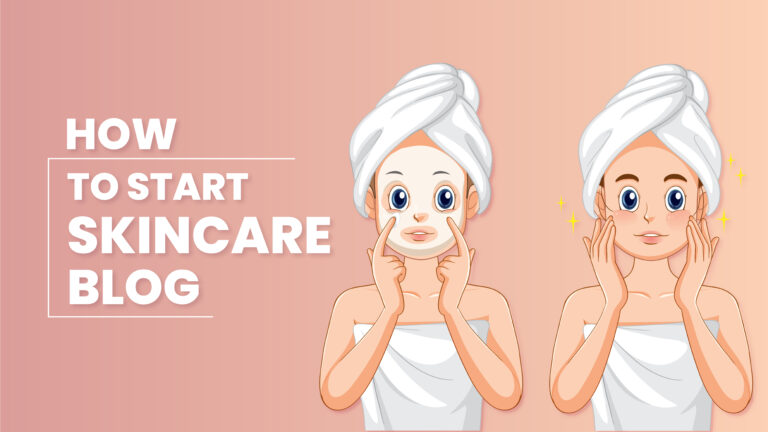The skincare industryis booming in 2026, and starting a skincare products blog is an ideal way to share your expertise, personal experiences, and product recommendations while building a profitable online platform. Readers are constantly searching for honest reviews, skincare routines, and expert guidance, which creates a strong demand for high-quality content.
A successful skincare blog is more than just writing reviews; it’s about educating your audience, building trust, and providing actionable advice. From understanding different skin types to explaining the benefits of ingredients like retinol, vitamin C, or hyaluronic acid, your blog can serve as a comprehensive guide that readers rely on.
What Is a Skincare Blog?
A skincare blog is an online platform where beauty enthusiasts, dermatologists, and influencers share content related to skin health, beauty routines, product reviews, and expert advice. It serves as a go-to resource for readers looking to improve their skin, discover effective products, and learn about ingredients.
Skincare blogs can cover a wide range of topics, including daily routines, anti-aging solutions, acne treatment, organic products, seasonal skincare, and luxury brand reviews. They often combine written articles with images, videos, and infographics to create engaging, informative, and actionable content.
The primary goal of a skincare blog is to educate, guide, and influence readers while also building a loyal audience. Bloggers can share personal experiences, review products, and provide trusted recommendations, establishing themselves as authoritative voices in the skincare community.
In 2026, skincare blogs are more than just hobby platforms; they are profitable, SEO-driven, and highly influential, allowing creators to monetize through affiliate marketing, sponsored content, digital products, and more, all while helping readers make informed skincare choices.
How to Start a Skincare Blog (Easy Steps)
1. Define Your Niche
To define your niche, consider the specific area of skin care that interests you. Popular niches include:
- Anti-Aging Products: Focus on products that reduce signs of aging.
- Acne Treatment: Explore solutions for acne-prone skin.
- Natural and Organic Skin Care: Highlight products made from natural ingredients.
- Skincare for Specific Skin Types: Cater to oily, dry, sensitive, or combination skin.
- DIY Skin Care Recipes: Share homemade skin care remedies.
Selecting a niche helps establish your authority. It allows you to attract a targeted audience. A focused approach leads to more engaging content.
2. Research Your Audience
To research your audience, utilize tools like Google Analytics and social media insights. Understand demographics, interests, and online behavior. This data helps tailor content to your readers’ needs. For example, younger audiences may prefer social media tips, while older readers might seek detailed product reviews.
3. Understand Market Trends
Understanding market trends involves analyzing the latest developments in the skin care industry. Use sources like Statista or industry reports to identify popular ingredients, products, and consumer preferences. Staying updated on trends allows you to create timely content. This practice enhances relevance and engages your audience.
4. Choose a Blogging Platform
To choose a blogging platform, consider options like WordPress, Wix, or Squarespace. WordPress is known for its flexibility and customization options. It offers various themes and plugins designed for beauty blogs. Wix is user-friendly for beginners, providing drag-and-drop functionality. Squarespace is known for its visually appealing designs. Select a platform that meets your technical skills and design preferences.
5. Select a Domain Name
To select a domain name, choose something memorable and relevant to your niche. The domain name should reflect your brand identity. Aim for a short and simple name. Use keywords related to skin care for better search engine optimization (SEO). Ensure the domain name is easy to spell and pronounce. Check for availability using domain registration sites like GoDaddy or Namecheap.
6. Set Up Your Blog
To set up your blog, follow these steps:
- Register Your Domain Name: Use a reliable domain registrar.
- Choose a Hosting Provider: Consider providers like Bluehost or SiteGround. They offer reliable performance.
- Install Your Blogging Platform: Follow the host’s guidelines for installation.
- Select a Theme: Choose a theme that reflects your aesthetic and is user-friendly.
- Customize Your Blog: Adjust colors, fonts, and layouts to fit your brand.
A well-structured blog enhances user experience. Ensure that navigation is intuitive.
7. Create Compelling Content
To create compelling content, focus on various types of posts:
- Product Reviews: Analyze skin care products in detail.
- How-to Guides: Offer step-by-step instructions on skin care routines.
- Ingredient Spotlights: Discuss the benefits of specific ingredients.
- Personal Experiences: Share your skin care journey for authenticity.
- Expert Interviews: Feature interviews with dermatologists or beauty influencers.
High-quality content establishes credibility. Use clear headings, bullet points, and images for better readability.
8. Focus on SEO
Focusing on SEO involves optimizing content for search engines. Use tools like Yoast SEO for WordPress to analyze your posts. Implement keywords strategically. Use them in titles, headings, and throughout the content. Meta descriptions and alt text for images also improve SEO.
- Keyword Research: Use tools like Google Keyword Planner to identify relevant keywords.
- On-Page SEO: Optimize titles, headings, and URL structures.
- Internal Linking: Link to other posts within your blog to enhance navigation.
9. Promote Your Blog
To promote your blog, use multiple channels:
- Social Media: Leverage platforms like Instagram, Pinterest, and TikTok. Share engaging visuals and links to your blog posts.
- Email Marketing: Build an email list to share newsletters and updates. Use tools like Mailchimp for management.
- Collaborations: Partner with other bloggers or influencers. Guest posts and collaborations increase exposure.
- Online Communities: Engage in skin care forums and Facebook groups. Share expertise and link to your blog when appropriate.
Promotion builds a community around your blog. It increases visibility and encourages interaction.
10. Monitor Your Analytics
To monitor your analytics, use Google Analytics or similar tools. Track metrics like page views, bounce rates, and user demographics. Analyzing this data helps identify popular content and areas for improvement. Regularly reviewing analytics allows you to refine your strategies.
- Identify Trends: Look for patterns in traffic sources and user behavior.
- Adjust Content Strategy: Create more of the content that resonates with your audience.
- Evaluate Marketing Efforts: Analyze the effectiveness of promotional strategies.
11. Engage with Your Audience
To engage with your audience, respond to comments and messages promptly. Encourage discussions on your blog and social media platforms. Create polls or surveys to gather feedback. Engaging with readers fosters a sense of community. It encourages loyalty and interaction.
12. Monetize Your Blog
To monetize your blog, explore various strategies:
- Affiliate Marketing: Join affiliate programs like Amazon Associates. Promote products and earn commissions on sales.
- Sponsored Posts: Collaborate with brands for sponsored content. Ensure the products align with your blog’s values.
- Ad Revenue: Use ad networks like Google AdSense to display ads on your blog.
Select monetization methods that suit your audience and content style.
13. Create an Affiliate Marketing Strategy
Creating an affiliate marketing strategy involves selecting relevant products to promote. Research affiliate programs that align with your niche. Use product reviews and recommendations in your content. Disclose affiliate relationships to maintain transparency with your audience.
- Join Affiliate Networks: Sign up for networks like ShareASale or Rakuten Marketing.
- Incorporate Links Naturally: Include affiliate links in relevant posts without being overly promotional.
- Track Performance: Use analytics to monitor affiliate link clicks and conversions.
14. Stay Updated with Trends and Be Consistent
To stay updated with trends, follow industry publications and influencers. Subscribe to newsletters from beauty blogs and brands. Participate in webinars and online courses. Continuous learning keeps your content relevant.
To be consistent, establish a content calendar. Plan your posts and stick to a schedule. Regularly updating your blog keeps your audience engaged. Consistency builds trust and encourages return visits.
- Follow Experts: Keep an eye on dermatologists and skin care specialists.
- Attend Events: Participate in beauty expos and conferences. Networking provides insights into industry developments.
- Post Frequency: Determine how often you will publish new content. Weekly or bi-weekly posts are common.
- Maintain Quality: Ensure each post meets your quality standards. Quality over quantity is essential.
15. Build a Brand Identity and Develop a Community
To build a brand identity, define your voice and aesthetic. Use consistent colors, fonts, and imagery across your blog and social media. Create a logo that represents your brand. A strong identity sets you apart from competitors.
- Establish Your Voice: Decide if your tone is casual, professional, or a mix. Use this tone consistently in all communications.
- Create Visual Consistency: Ensure your visual elements reflect your brand’s personality.
To develop a community, engage with your audience across platforms. Host live Q&A sessions on social media. Create a private Facebook group for your followers. A community fosters loyalty and encourages interaction among members.
Conclusion
Launching a skincare blog in 2026 presents a fantastic opportunity to share your expertise, review products, and connect with a passionate audience. Success begins with defining your niche, whether it’s anti-aging, acne solutions, organic skincare, or luxury products, and understanding your target readers’ needs and preferences. Creating high-quality, informative, and engaging content is crucial for building authority and trust.
To grow your blog, implement effective marketing strategies, including SEO optimization, social media promotion,and email newsletters, to reach a wider audience. Regularly analyzing traffic and engagement metrics helps refine your content strategy, while actively engaging with readers fosters a loyal community. Monetization options such as affiliate marketing, sponsored posts, and digital products can turn your passion into a profitable venture. By staying consistent, following industry trends, and delivering genuine value, your skincare blog can become a trusted resource and a successful online business.
Frequently Asked Questions (FAQs)
hat Is the Best Niche for a Skincare Blog in 2026?
Choosing a niche is critical for attracting a dedicated audience. Popular options include anti-aging solutions, acne treatments, organic skincare, men’s skincare, and luxury beauty products. Select a niche that aligns with your expertise and interests while having demand in search trends.
How Can I Effectively Promote My Skincare Blog?
Promote your blog by leveraging social media platforms like Instagram, TikTok, and Pinterest, using email newsletters to connect with subscribers, collaborating with skincare influencers, and engaging in online communities and forums focused on skincare.
Which Blogging Platform Is Best for a Skincare Blog?
WordPress is the most recommended platform due to its flexibility, SEO capabilities, and customization options. For beginners, platforms like Wix or Squarespace are user-friendly alternatives that offer drag-and-drop designs and easy setup.
How Can I Make Money from a Skincare Blog?
Monetization options include affiliate marketing with beauty and skincare brands, sponsored posts from companies, display advertising using networks like Google AdSense, and selling digital products such as eBooks, courses, or guides.
How Often Should I Post on My Skincare Blog to Grow Traffic?
Consistency is key. Aim for 1–2 high-quality posts per week. Regular updates improve SEO rankings, keep your audience engaged, and establish your blog as a reliable resource.
What Type of Content Performs Best on a Skincare Blog?
Content that educates and solves problems performs well. Focus on product reviews, tutorials, ingredient guides, comparison posts, skincare routines, and trending skincare topics to attract readers and improve search visibility.
How Do I Build a Loyal Audience for My Skincare Blog?
Engage with readers through comments, social media interactions, and newsletters. Providing trustworthy advice, honest reviews, and interactive content helps build a loyal, long-term community.

